How Much Weight Can a Wood Deck Hold
Deck Load Chapters And Tributary Area: How they relate
What a dandy question.
The question around deck load capacity is ane I receive frequently from visitors asking how much weight should they design their deck for.
The word rapidly leads to the overall force of the framed structure. But that is only one part of it.
That is considering any assay of what load a structure may bear upon itself and its foundation must involve the
support post networkand
soil bearing capacity.
The Entire Deck, Footings And Soil Are A System
Information technology truly is a system - non unlike a chain - where the weakest link will lead to the failure of the deck.
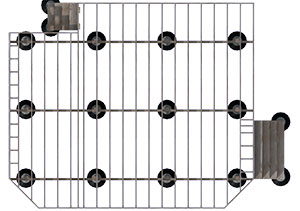
People Go Intimidated By The Thought of Math and Engineering
Many people are intimidated with trying to effigy out the load capacity for a deck.
Even some contractors are not sure where to begin and so they merely over build – which may exist entirely unnecessary and price y'all more money. Another problem that tin arise from over edifice is a sinking deck.
Yes, even if you build a strong deck information technology tin gradually sink into the soil if you lot do non consider the size of footings with respect of the load for the deck. Once your deck starts sinking it tin rip the ledger board abroad from the house or you will have to jack upwards the sunken expanse, excavate and pour a new larger footing.
That is what we will cover in the second half of this article.
Simply Some Basic Math Is All That Is Needed
The expert news is the concepts and the math used for determining loads on decks and other structures are quite unproblematic.
I will explain how to do it and and so yous tin go build that deck with confidence knowing it will be strong and stable and standing years from now.
Permit's Get-go At The Top And Work Down
The first area to think of is the actual framed deck. This structure is comprised of perimeter joists - sometimes chosen rim joists or band joists. Then there are the joists in the eye. These are sometimes called infield joists or inner joists. You will hear a number of terms.
This framework is supported by a number of beams - sometimes called carrier beams because they "carry" the load of the construction.
Blueprint Load, Dead Load, Live Load - What does this hateful?
Design Load
The IRC and other like codes in other countries, like Canada or the UK all work from a like starting point for what a flooring deck should be engineered to support.
These standards are borrowed past deck builders and come from the actual lawmaking requirements used for the floor deck of a residential dwelling house.
The load that is placed on your deck is expressed in pounds per square pes (psf) and the full load or more appropriately, the design load, is comprised of the dead load and the live load.
Dead load is basically the load created by the weight of the deck itself. This is commonly near 10 psf.
Alive load is created past all the extras similar piece of furniture, planters, and people. This is ordinarily about 40 psf. Together the blueprint load would be fifty psf.
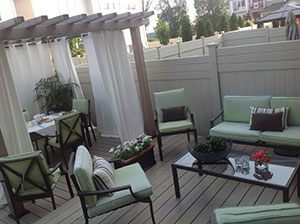
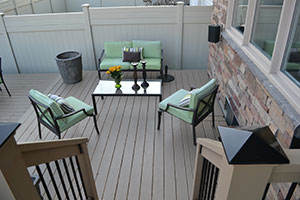
Snowfall load anyone?
Of form, if you look a lot of snowfall to sit on your deck over the winter or envision an 8,000 lb hot tub on the deck this could increment the required load capacity of your deck upwards to 100 psf.
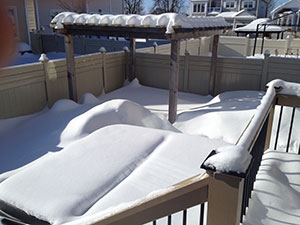
Not all locations experience seasonal changes similar the ane depicted in the series of photos. But given the corporeality of snowfall piled up on this deck you can encounter why it is important to consider all the forces that will be at piece of work on your deck and then summate and build accordingly.
Framing For The Design Load
To avoid referring to complicated engineering tables and for the purpose of building a deck, let us start with the thought that using standard 2x8 softwood lumber at 16" o.c. joist spacing your deck will hands meet the 50 psf threshold.
What Most Snow Load Or a Spa Tub
Yes, this is a business organization but the net effect or changes you might have to do to increase the strength of the deck could be as simple as using 2x10 joists at 12" o.c. spacing.
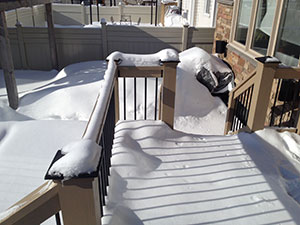
The framed structure volition typically handle the added weight quite easily.
The worry will be your beam spacing, back up postal service size and most importantly how many footings and how much weight will they impose directly on the soil below.
This is critical considering if you lot overload the soil more than it can bear, the deck will start to sink. A very bad thing.
now Let's find the tributary areas of a deck
To make up one's mind the maximum load chapters of your deck, outset by calculating its total surface area and multiply by 50 psf. Then, a 100 sqft deck would be designed to back up 5000 lbs.
Do not get confused with what weight you might recollect or want to load the deck with.
If you drove a dump truck over it, yes this would throw all our calculations out the window. But we are building a deck to back up known loads consistent with the purpose for which the structure is known to exist used for and the 50 psf number has a safety factor in it. That is why engineers accept settled on this as a safe value.
So with a total deck load chapters of 5000 lbs nosotros now move to the "slightly" more than complicated discussion about tributary areas and how this overall load is now distributed around the entire deck and onto the soil below. Stick effectually. This is the fun part.
Our example: a 10' ten 10' Deck
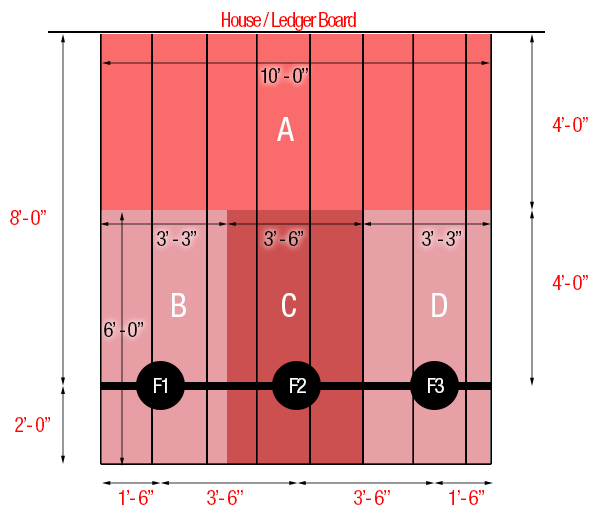
Four Tributary Zones: A, B, C, D
Our deck is equally simple as it gets to illustrate the concepts deck load capacity and transfer of weight within each tributary area. This deck is ten`x10` or 100 sqft.
At that place is a ledger board attached to the house. The joists run perpendicularly out from the house for x feet at xvi inches on eye. The carrier beam runs perpendicular to the joists with its center at 8 feet from the firm and the cantilever across its center point is two feet.
At that place are three support posts iii.v feet from centre to center. The beam cantilevers 1-half dozen` by the outer posts to the perimeter of the outer almost joist.
For case the unsupported section from the ledger board to the axle is a distance of eight'. Therefore the first midpoint is 4' from the house and marks the separation between supported load areas as you move outwards from the house. Area A equals 4x10 or 40 sqft.
Defining Tributary Areas Of The Deck
There are iv tributary areas on this deck: A, B, C and D.
Tributary Surface area A is confined betwixt the midpoints of its two adjacent back up members, the ledger board, and the beam. The exterior perimeter joists confine the width of the area.
Area A
For example the unsupported section from the ledger board to the beam is a altitude of 8'.
Therefore the showtime midpoint is iv' from the house and marks the separation betwixt supported load areas as you movement outwards from the firm.
Area A equals 4x10 or forty sqft.
This means that the force exerted over the deck between the beam and the house is supported l% by the ledger board and house and 50% by the beam.
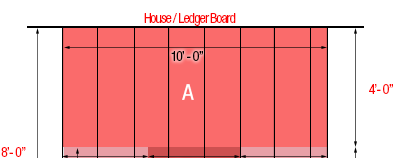
Expanse B
Area B extends from the 4' bespeak outward to the beam and across to the finish of the deck.
Since in that location is no support fellow member by the axle the length of this load area is 6' (from the 4' mark to the 10' mark).
The width of Area B extends to the midpoint betwixt the end post and the eye mail service.
The end post is i.5' from the end of the beam. The altitude between the end mail service and the eye post is 3.5'. Therefore the midpoint betwixt the two posts is 1.75'.
That means the full width of the first supported load area extends from the terminate of the beam to the 3.25' marking along the axle (i.5' + one.75').
The dimensions of Surface area B are 6x3.25 or 19.five sqft.
Incidentally, tributary Area D is identical to B.
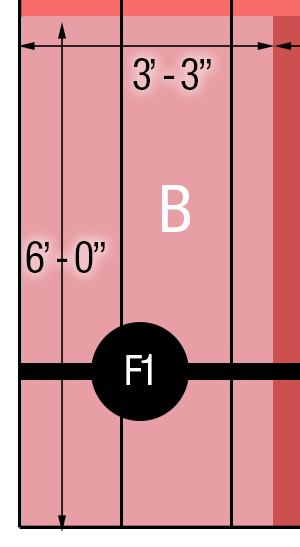
Area C
Tributary area C is slightly larger than B and D. It is vi`long but its width extends from the midpoint of footing F1 to F2 and F2 to F3. This altitude is 3.5`. Surface area C is 6x3.5 or 21 sqft.
Load Calculation for Each Tributary Area
A= 40sqft ten 50psf or 2000 lbs
B= 19.5sqft x fifty psf or 975 lbs
C= 21 sqft x 50 psf or 1050 lbs
D= 19.5sqft x l psf or 975 lbs
Detect that the middle tributary zone must conduct more weight than the adjacent areas B and D. This is a common characteristic you volition notice in most decks and then quondam, if your begetting capacity of the soil is quite low, yous may take to increase the size of the middle footings or add another support mail to not overload the soil.
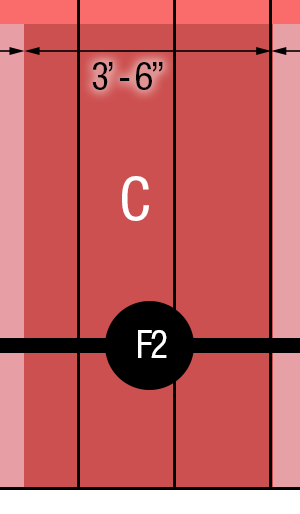
Expanse D
Area D is identical to Area B. Given the shape and support configuration of the deck is symmetrical. The dimension are 6x3.25 or 19.5 sqft.
Lastly, Area A is supported by the ledger board across its entire length. Nosotros express this load value equally lbs per lineal foot.
The ledger is 10' long then every foot of ledger must be designed to carry at to the lowest degree 200 lbs of load.
Engineer To Your Largest Tributary Area
Now that nosotros know the loads nosotros look to exist exerted on each mail below each tributary area and thereby onto the soil below, we can design the size of our footings combined with whatever knowledge we may accept nigh the soil blazon.
For example, I would design the footings for the other posts to as well handle this 1050 lbs load - engineer up to the highest mutual denominator.
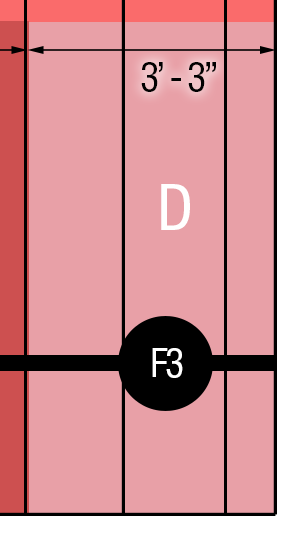
Bearing Capacity of Soil
This is the final area of concern. The type of soil determines how heavy the load can exist before the footing is susceptible to settling. Organic soils are the worst. If y'all have organic soils with rotting material it must be removed and replaced with granular stone and compacted earlier a footing can be installed.
The other types of soils most encountered are clays which have varying degrees of moisture. The concept is that the more moisture retained in the soil, the lower its bearing capacity. The typical range of bearing capacity for clays, starting with the softest with college moisture content to the hardest with lowest moisture content is betwixt 2000 psf and 8000 psf or more, respectively.
In our example the maximum load any of the footings will encounter is merely over 1000 psf. Information technology is unlikely that soil conditions would be a major business concern in this deck building project. If you do find the soil is questionable, the best solution is to become a Soil Engineer to run a quick examination to determine the all-time course of action.
You should at present be ready to get off and first building your brand-new deck confident that information technology will handle the load you are going to throw at information technology.
Let usa assume this soil is typical and can easily bear 1800 psf. We will piece of work with that.
Footing Sizes
If each footing were i sqft then all the weight of the given area would be imposed over that 1 sqft area. Therefore, if the footing was twice every bit big or two sqft only 525 lbs (one-half of 1050) would be imposed on each sqft below Surface area C.
We can effectively reduce the strength imposed over a given surface area by using a larger ground size and distributing that weight over the larger area.
We could build a foursquare footing that is 12"x12" or one sqft and nosotros would be fine considering all the tributary areas acquit total weights much less than the soil's begetting capacity of 1800 psf.
But let us use a round footing because we bought some concrete tubular forms. If we use a xvi" bore course we tin can summate its surface area by using the formula for area of a circumvolve as π r². This works out to approximately 1.4 sqft.

Final Load Imposed On Soil
To determine what weight per square human foot is actually imposed on the soil below each tributary surface area, nosotros simply divide its weight by the area of the footing. Let's see what values nosotros get for each footing.
F1= 975 lbs/1.iv sqft= 696 lbs
F2= 1050 lbs/1.four sqft=750 lbs
F3= 975 lbs/ane.4 sqft= 696 lbs
In every example the loads imposed are less than one-half and almost a tertiary of what the soil really could deport. So, your deck will not sink into the ground.
Become ahead and build the frame every bit strong as yous wish. But go along in mind the two concepts of the strength of the construction and the bearing chapters of the soil. This is a uncomplicated deck to make these calculations with and is very helpful at illustrating the concept.
It tin can get trickier equally y'all change the complication of the shape. But if you know and understand these key principles, deck load capacity questions will be piece of cake for you.

Richard Bergman is the editor of DecksGo.com and a builder of custom homes and also many decks and fences to mention. He is also an active product developer and patent holder. Richard holds a B.Comm and LLB degree and particularly enjoyed patent law.
Beyond theory, he loves taking ideas and turning them into physical realities and that is why he builds. He is always working on something interesting and loves to share his noesis with those who may need some assist.
If you would like to be a featured builder and share an original commodity of interest to our visitors contact us and let the states know.
Home > Building a Deck > Deck Load Chapters
kittlesonlathand74.blogspot.com
Source: https://www.decksgo.com/deck-load-capacity.html
0 Response to "How Much Weight Can a Wood Deck Hold"
Post a Comment